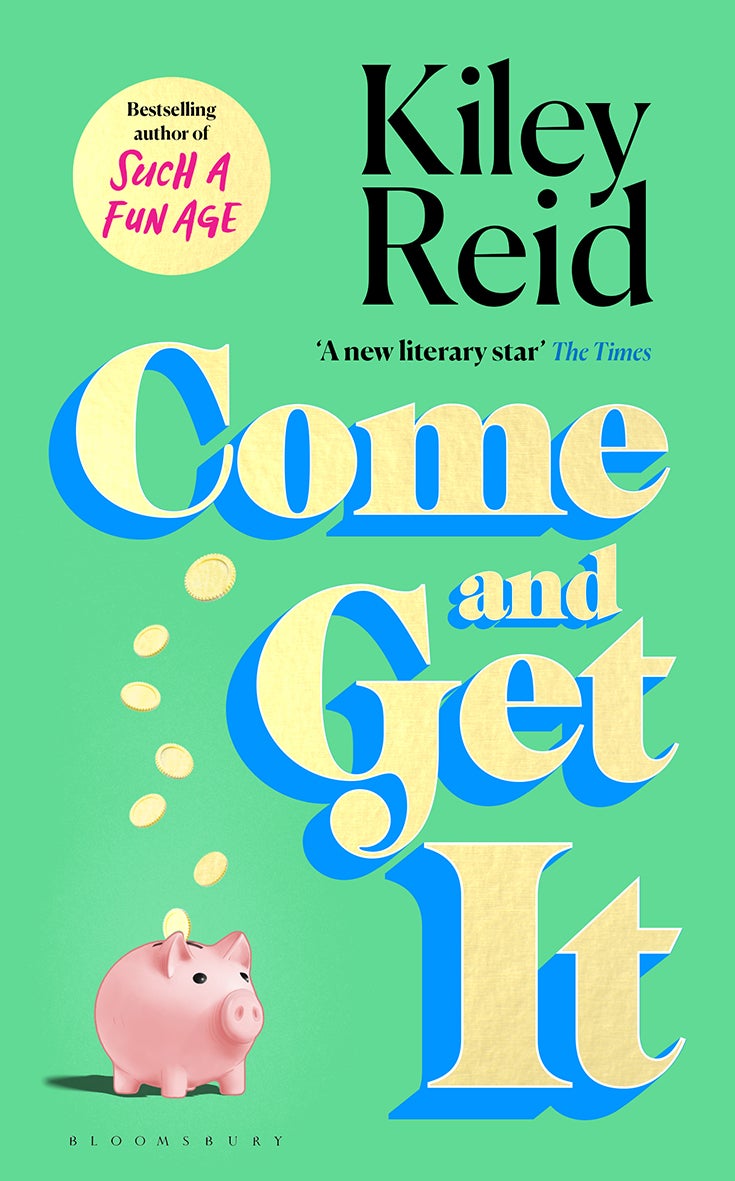Kiley Reid’s Come and Get it and the (cost of living on) campus novel
The dark academia of Donna Tartt’s ‘The Secret History’ has given way to a new kind of contemporary campus story. From Kiley Reid’s second novel to the seedy secrets in ‘Saltburn’, the journeys of self-discovery made by today’s characters are disrupted by issues of wealth and finance, writes Katie Rosseinsky


Every university seems to have one hall of residence that no one wants to live in. The one that looks like a multi-storey car park, but less appealing. The one with the smell. Its inhabitants refer to it in apologetic, self-deprecating tones; everyone else makes jokes about the sort of people that end up there.
In Come and Get It, Kiley Reid’s follow-up to her best-selling 2020 debut Such a Fun Age, that building is the fictional Belgrade dormitory. The rest of the University of Arkansas, Reid tells us, has a “screen-saver, campus-visit, Scholastic Book Fair beauty to it”, but Belgrade seems exempt from those charms. It is where students are allocated rooms last minute, perhaps after a series of admin errors. Being associated with it has its own niche social stigma. Most of its inhabitants are on scholarships, so the subtext is that they can’t afford to complain; others have transferred from other institutions, arriving at Belgrade with no idea of its pariah status.
Such a Fun Age offered an incisive, deftly handled take on weighty topics like race and privilege, telling the story of two women: Emira, a young Black nanny who is accused of kidnapping her white charge during a late-night trip to a supermarket, and her employer Alix, a girlbossy feminist influencer. Reid was especially sharp on liberal guilt; her novel preceded the Black Lives Matter marches of summer 2020 by a few months, but you could definitely imagine Alix posting a performative black square on her Instagram account “in solidarity”. In her second book, Reid brings her sharp gaze to the classic campus novel, and university life provides her with similarly rich material when it comes to deconstructing privilege.
She also cleverly turns some of the genre’s dustier tropes on their heads. In Come and Get It, professors are hustling for a second income. Agatha Paul, a visiting professor and journalist, arrives at Belgrade to research her next book. With the help of Millie, a resident advisor at the dorm, she sets up a meeting with a group of undergraduates. The conversation turns towards money, and Agatha is rapt as the girls – each of them definitely thinks that they’re not the usual Belgrade type – tell her about their hefty allowances (or “practice paychecks”). Soon, she is eavesdropping on conversations through the walls of Millie’s room, then packaging them up as online “Money Diary” features for Teen Vogue; each piece details their monthly incomings, outgoings and spending habits. The girls have no idea they’re being spied on, and this is not the only ethical boundary Agatha will bend during her time on campus. Is it wrong for her to have a relationship with a student, if that student isn’t her student? (Usually, of course, it’s a middle-aged male professor who is having these conundrums over a beautiful female student, something Julia May Jonas’s recent campus novel Vladimir turned on its head. Agatha, though, sometimes seems to use her gender and her sexuality to give herself a free pass).
Campus novels are often novels of ideas. They’re filled with wordy debates between idealistic undergraduates (as in recent-ish additions to the canon like Sally Rooney’s Normal People and Elif Batuman’s The Idiot), or generational clashes between teachers and students. But Come and Get It never ventures inside the classroom; barely one scene takes place in a lecture theatre. Instead, Reid is much more interested in the economics of how her students got there, and what they’re doing to get by. Reid, herself an assistant professor at the University of Michigan (who carried out her own Agatha-style interviews with students while researching her book), doesn’t let us forget that higher education in America can be big business. Private universities are often sitting on massive endowments from wealthy alumni (Harvard endowment is more than $50bn, exceeding the GDP of more than 120 countries) but charge an average of around $35,000 in annual tuition fees, leaving many saddled with huge debts (public colleges are cheaper, especially in your home state).
Money is Come and Get It’s animating force. Its effects are particularly pronounced in the dorm: some students are on scholarships, some are cushioned by parental wealth, and some, like Millie, who’s described as “the type of student that college student-service centres swept up for pictures and profiles”, even have to work for their wealthier peers. As resident advisors, she and her colleagues Ryland and Colette carry out health and safety checks, put on various forms of organised fun for the dorm’s inhabitants and detangle disputes between roommates; they’re each paid $250 per month. It’s a sum that seems especially paltry when you compare it to the tens of thousands of dollars they will be handing over in tuition fees.
Millie likes her job as a RA, takes it seriously, even, and she’s aiming to save up for her own home, “after becoming mildly addicted to TV shows featuring tiny houses and youngish owners”. But the dynamic (working where she lives, living where she works, and essentially serving her contemporaries) is still uncomfortable, not least because there’s a racial element to this already complicated dynamic too (Tyler, the most self-confident of the girls who Agatha initially interviews, claims Millie, who is African American, “can be… a little ghetto”, before doing an awkward impression of her mannerisms).

Each character’s financial status is painstakingly documented by Agatha (who applies a similarly forensic approach to spending in her personal life; we learn that disagreements over money have soured her relationship with her profligate ex-girlfriend, Robin). And monetary transactions become plot points: a $20 tip, handed to Millie in the opening scenes, will come back to haunt her towards the novel’s end.
The campus novel has always had a habit of painting universities as worlds outside of time. A book like Donna Tartt’s The Secret History ostensibly takes place in the Eighties, when Tartt herself was a student, but it could easily be set years earlier. In Brideshead Revisited, most of the Oxford students are following traditions that their fathers, grandfathers and beyond would recognise. The same is true of Emerald Fennell’s film Saltburn, which rips off Brideshead quite shamelessly: if it wasn’t for the Livestrong wristbands and Jack Wills rugby shirts, you might not know that it was set in the mid-Noughties.
The campus novel has always had a habit of painting universities as worlds outside of time
In these stories, your undergraduate years are a period when pragmatic concerns can be put to one side for a while, in pursuit of big ideas, friendships, drinking, growing up (or, in the case of The Secret History, learning ancient Greek and doing murders). Students can exist outside the boring boundaries of adulthood, high on the sense of their own potential, with plenty of time to explore; they might be living on borrowed money, but they don’t have to think about that yet. But that feels increasingly like, well, fiction. In Come and Get It, Reid’s less privileged students get no such grace period. They’re graduating in an era when student debut is overwhelming and the housing market is impossible. Is it any wonder that many of them are constantly engaged in some form of accounting? Reid’s story might lack some of the heady drama of those more traditional campus tales, but it makes up for it in realism and relatability.
The (literal) cost of this rite of passage has seeped into other recent additions to the genre too. Caroline O’Donoghue’s The Rachel Incident, released in 2023 but set in Ireland around the 2008 recession, is a coming-of-age story with university as its loose backdrop – but most of the coming of age is shaped by what occurs at the main character’s part-time job, one she needs to subsidise her studying. Brandon Taylor’s 2020 debut Real Life, meanwhile, deftly dramatised the emotional impact of constantly feeling out of step – financially, socially, emotionally – with your academic peers. Even Saltburn, in its panto-ish way, gestures towards the gaps between the “haves” and the “have nots” on campus, with protagonist Oliver (Barry Keoghan) manipulating his origin story to attract the attention and sympathy of his upper-class classmates.
Part of what has always made campus stories so captivating is that they show us character as a work in progress –because our university days have always been about working out our sense of self. But contemporary tales like Reid’s are a necessary reminder: this leisurely exploration is a luxury not everyone can afford.
‘Come and Get It’ by Kiley Reid is published by Bloomsbury on 30 January, £16.99
Join our commenting forum
Join thought-provoking conversations, follow other Independent readers and see their replies
Comments
Bookmark popover
Removed from bookmarks